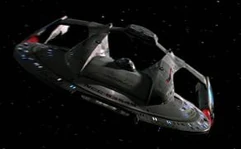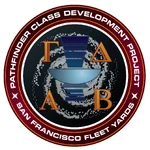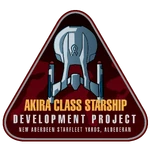| Akira-class Starship | |
|---|---|
 USS Thunderchild | |
|
Owner: |
|
|
Operator: |
|
|
Type: |
Escort Cruiser |
|
Status: |
Active |
|
Length: |
464.43 meters |
|
Beam: |
316.67 meters |
|
Height: |
87.43 meters |
|
Crew Complement: |
500 |
CLASS DESCRIPTION[]
Active as early as 2371, Akira class ships have been involved in many large-scale Starfleet engagements. Beginning with the second Borg incursion, ships such as the Thunderchild were instrumental in protecting earth. Throughout the Dominion War, Akira-class ships were heavily involved in both defensive and offensive actions, including Operation Return and the final offensive on the Cardassian homeworld.
Initial designs placed the Akira-class in a variety of roles, ranging from torpedo gunship to carrier. The final production model was a hybrid design, combining most of these roles with a fairly high maneuverability for its size. The Akira is versatile and able to perform a variety of tasks, ranging from scientific missions, to escort, to diplomatic conveyance.
Ships of the class:[]
- USS Akira (NX-62497)
- USS Geronimo (NCC-62501)
- USS Black Elk (NCC-62878)
- USS Osceola (NCC-62743)
- USS Susquehanna (NCC-63419)
- USS Nez Perce (NCC-62891)
- USS Rabin (NCC-63293)
- USS Mateo (NCC-63302)
- USS Red Cloud (NCC-63306)
- USS Thunderchild (NCC-63549) (decomissioned)
- USS Thunderchild (NCC-63549-B
- USS Sentinel (NCC-1733-A) (destroyed)
- USS Devore (NCC-64088)
- USS Spector (NCC-65549)
- USS Antietam (NCC-67433)
- USS Geronimo (NCC-69302)
- USS Jupiter (NCC-71267)
- USS Leyte Gulf (NCC-71427)
- USS Svorkia NCC-79674
- USS Musilla (NCC-82832) (decommissioned)
- USS Ayanami (NCC-92777) (destroyed)
- USS Grissom
- USS Ankara (NCC-93635)
- USS Carolina NCC-93826 (destroyed)
- USS Armitage (NCC-97300)
- USS Alita (NCC-97305)
- USS Okita (NCC-97329)
- USS Poseidon (NCC-97331)
- USS Chevalier (NCC-98186)
- USS Mitterano NCC-98874
- USS Ayanami (NCC-99777)
VARIANTS[]
Akira[]
The original and most well-known version of the class, the Akira has been in service for over 50 years, and has proven itself a capable platform throughout its career. Initially billed as a torpedo assault ship, the Akira featured no less than 17 torpedo launchers, 12 of which were located in the rollbar, 2 on either side of the saucer, and 1 just above the navigational deflector. Unlike most Starfleet ships, the Akira was capable of firing in all directions simultaneously, rather than only fore or aft. In contrast to the seemingly overwhelming firepower of its launchers, the Akira featured only limited phaser capabilities, with a primary phaser array on the dorsal saucer, two smaller arrays on the ventral saucer, and four small arrays on the rollbar itself. Due to this high torpedo coverage and limited energy output, the Akira worked best with support ships like the Saber or Defiant.
Oslo[]
Introduced in the mid-2380's, the Oslo class was an attempt to make a more streamlined ship. Featuring a more severe incline to the engineering hulls, the nacelles were less exposed than the standard Akira. However, the Oslo also eliminated the Rollbar from the design and relocated only a portion of the launchers to the engineering hull itself. As such, what the Oslo gained in slipstream geometry, it lost in firepower.
Thunderchild[]
In an attempt to reconcile the problems of the Oslo and Akira, the Thunderchild kept the more streamlined design while adding a redesigned rollbar back. Rather than using 12 single-fire torpedo launchers, the new rollbar instead used 4 of the newer rapid-fire launchers first introduced with the Sovereign class. The recovered space allowed for additional torpedo storage and manufacturing equipment, which allowed the Thunderchild to be better equipped for long-term deployments. The class also incorporated an experimental rapid-fire phaser defense turret, which was intended to target torpedos and small craft, and dedicated forward-firing phaser cannons. In addition, the Thunderchild also featured an expanded shuttlebay, which allowed the new variant to support a larger complement of support craft, including fighters in limited numbers.
Armitage[]
In an attempt to build on the initial bay expansions of the Thunderchild, the Armitage features a large underslung shuttlebay, which is capable of supporting a full squadron of fighters. The added mass of the bay and required support structures required a rearrangement of the ship, as well as an expansion of various features across the entire frame. As a result, the Armitage is easily the largets of the Akira variants, although it still maintains its durability.
Alita[]

In an attempt to reconcile the increased size requirements of the Armitage in a smaller spaceframe, the SCE introduced the Alita class. Featuring a smaller but more efficiently organized shuttlebay, the Alita also kept its impressive arsenal of torpedos, forward cannons, and phaser arrays. Due to the reduced mass in comparison to the Armitage, the Alita is just as agile as the Akira without sacrificing either firepower or support craft capacity.
SPECIFICATIONS[]
Physical Arrangement:[]
Deck Layout:[]
Propulsion Systems:[]
Warp Drive:[]
Standard Warp systems
- Normal Cruise : 6
- Maximum Cruise : 9.3
- Maximum Rated : 9.84 for 124 hours
Tactical Systems:[]
Phaser Beam Emitters:[]
- Primary phaser array (located on the dorsal surface, around the saucer)
Torpedo Launchers:[]
- Quantum / Photon launchers (x4, located on the rollbar facing forward)
- Photon / probe launcher (x1, located just above the deflector dish)
Deflector Shields:[]
Standard shields
Armor/Hull:[]
Standard Tritanium armor
INTERIOR DESIGN[]
Bridge:[]
Medical Facilities:[]
Main Engineering:[]
Crew Quarters:[]
Mess Hall/Lounge:[]
Transporter Rooms:[]
GALLERY[]
?????-class Images:[]

